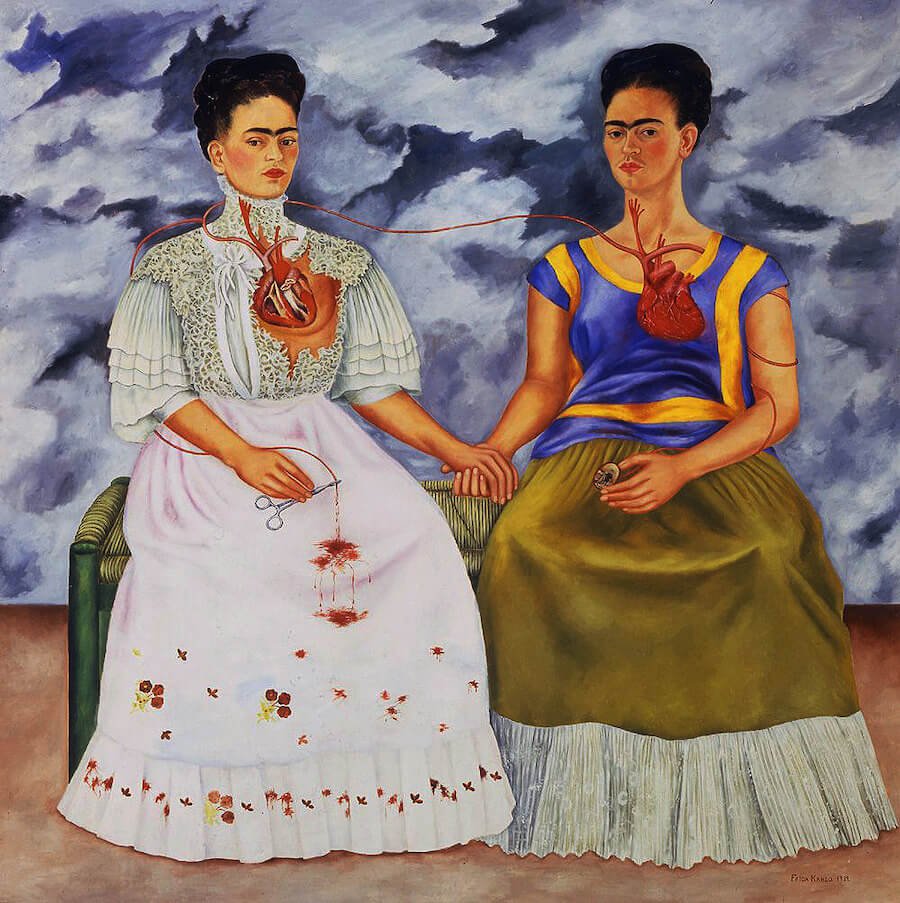The Two Fridas, Frida Kahlo
Frida Kahlo, The Two Fridas (Las dos Fridas), 1939, oil on canvas, Museo de Arte Moderno, Mexico City.
One of the most renowned artists of the 20th century, Frida Kahlo’s works serve as a continuous timeline of her emotional struggles, physical ailments, successes and struggles in marriage, and her mixed heritage. through numerous health episodes, a struggle to find her true identity, and her tumultuous love life with Diego Rivera, The Two Fridas is a visual culmination of her short, but fascinating life.
Unlike many artworks that are not easily identifiable with one particular artist, every work by Kahlo can easily be accredited to her, likely because of her distinct appearance – namely, her facial hair. Her distinctive inclusion of facial hair sets her apart from other artists as she uses her own image to display themes of love, loneliness, and heritage.
In an era when women typically stuck to grandiose coiffures and dress, Kahlo separated herself as a defiant outsider. Whereas the common woman of the time championed European dress, similar to the white dress Kahlo dons in The Two Fridas, she often wore indigenous clothing. Adhering to domestic roles was the norm amongst middle-class women during the time, but Kahlo used her self-portraits to defy the conventional beauty standards and societal expectations of the time. She used these works to comment on complex and challenging topics, including her heritage, the permanent impact of her medical history, and the second-class status placed on women.
The Two Fridas depicts two identical figures sharing a bench holding hands, differentiated by their distinctive dresses. Prior to her union with Diego Rivera, Kahlo, maintaining her European roots, dressed in elaborate attire as seen in her first self-portrait. However, after marrying Rivera, she began to don uniquely Mexican attire, embracing the Mexican customs she also felt connected to. The double self-portrait, which strays from her typical oeuvre, suggests a departure from the traditional definition of a self-portrait.
Similar in style to “Frieda and Diego Rivera,” The Two Fridas celebrates their marriage while also evoking a sense of loneliness due to her husband’s fidelity. Despite the piece’s sense of suffering, it helps serve as a bookend to the portrait of her and her husband, providing closure to their union. The two Fridas hold hands, symbolizing a strong bond between the two, and a vein unites them, reflecting both literal and figurative ties.
On the left, one Frida possesses a heart that is rather torn and exposed, while the other is strong. The Frida on the right yearns for her lost love with Rivera, shown by a vein feeding into a picture of a young Rivera held in her hand. On the other hand, the European-style Frida uses a hemostat to clamp down on the tie, alluding to a sense of resilience. Her works graphically expose human anatomy, and her personal experiences, including contracting polio as a child and her bus accident at 18, which left her unable to bear children, left her bedridden for much of her life. Thus, she uses blood ties and anatomical exposure to reflect her coping mechanisms, dealing with isolation and depression.
Her unique self-portraits nearly make up her entire discography, and she established a connection between her self-portraits and her solitude. In a statement made to a close friend, she detailed her style, saying, “I paint self-portraits because I am so often alone, because I am the person I know best.
